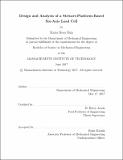Design and analysis of a Stewart-platform-based six-axis load cell
Author(s)
Ruiz, Maria Rosa, S.B. Massachusetts Institute of Technology
DownloadFull printable version (5.596Mb)
Other Contributors
Massachusetts Institute of Technology. Department of Mechanical Engineering.
Advisor
H. Harry Asada.
Terms of use
Metadata
Show full item recordAbstract
In this work, a six-axis load cell based on the geometry of a Stewart platform was developed. Its geometry and functional requirements were motivated by the needs of robotic limbs designed to be attached to human workers to support them in typically unergonomic positions. The sensor can measure forces and torques in six degrees of freedom, and can stably support the worker in various hanging positions while still being sensitive to load measurements in different directions. Furthermore, it is made from inexpensive, commonly available cantilever beam load cells. In the least accurate direction, Mx, our measurements were consistently 20% below the nominal applied load. In the most accurate directions, Fx, My, and Mz, our measurements were consistently within 5% of the nominal applied loads. Performance can be optimized using the condition number of the transformation matrix. The full-scale version of the hex sensor is also designed and optimized based on its condition number.
Description
Thesis: S.B., Massachusetts Institute of Technology, Department of Mechanical Engineering, 2017. This electronic version was submitted by the student author. The certified thesis is available in the Institute Archives and Special Collections. Cataloged from PDF version of thesis. Includes bibliographical references (page 43).
Date issued
2017Department
Massachusetts Institute of Technology. Department of Mechanical EngineeringPublisher
Massachusetts Institute of Technology
Keywords
Mechanical Engineering.